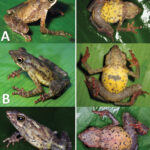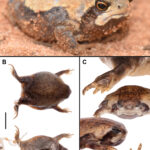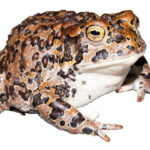Atelopus muisca: Discovering Colombia’s Endangered Jewel of the Andes#
Amidst the lush cloud forests and pristine streams of Colombia’s majestic Eastern Andes, hidden within softly curling mists and carpeted by a vibrant mosaic of mosses, dwells a vividly colored frog whose existence has become emblematic of hope and conservation urgency. The Atelopus muisca, commonly known as the Muisca Harlequin Frog, represents a striking tale of nature’s fragility and resilience. Revered for its brilliant coloration, distinctly slim form, and tragic decline, this diminutive amphibian captivates biologists, conservationists, and nature enthusiasts alike.
Named in honor of the indigenous Muisca people who historically inhabited this region, the Atelopus muisca embodies the harmony and interconnectedness deeply rooted in local cultures and ecosystems. Today, it has become a beacon of conservation—a call to action for preserving biodiversity hotspots that are rapidly vanishing worldwide.
Taxonomy and Classification#
First described scientifically in 1992 by biologists Ardila-Robayo and Ruiz-Carranza, the Atelopus muisca belongs to the family Bufonidae, a diverse and widespread group collectively known as the “true toads.” However, despite their family association, species within the genus Atelopus are affectionately referred to as “Harlequin Frogs,” famous for their vibrant coloration and intriguing adaptations.
The genus name “Atelopus” itself originates from the Greek terms “atelēs,” meaning imperfect or incomplete, and “pous,” meaning foot—a nod perhaps to their slender limbs and distinctive posture. Among over 90 recognized species of Atelopus, the Atelopus muisca is particularly captivating due to its sharply contrasting coloration and specialized montane habitat preferences that set it apart as a shining jewel in Colombia’s amphibian crown.
Natural Habitat#
Geographic Distribution#
Atelopus muisca is endemic to Colombia, specifically confined to a limited range within the Eastern Andes near Bogotá, primarily around the cloud forest areas of Chingaza Natural National Park and the nearby páramos (high-altitude tropical ecosystems). This restricted range makes the species inherently vulnerable, resulting in ongoing concerns over environmental changes and human encroachments such as agriculture and urban expansion.
Habitat Preferences#
Inhabiting elevations ranging from approximately 2,800 to 3,400 meters above sea level, Atelopus muisca thrives in montane cloud forests and humid páramos rich in moisture and vegetation cover. There, conditions offer perpetual humidity, cool temperatures, and complex terrain with moss-covered rocks, crystalline streamlets, and dense epiphytic communities. These conditions facilitate gas exchange through their semi-permeable skin—a defining trait among amphibians, demanding exceptionally pristine environments free from pollutants and pathogens.
Physical Characteristics#
Vivid and commanding in its coloration, Atelopus muisca stands as an undeniable visual marvel. An adult typically measures between 2 and 4 centimeters in length, presenting a slender body structure with remarkably elongated limbs, ideally suited for navigating their rocky, moss-covered habitats.
The hallmark of this charismatic species undeniably lies in its striking coloration. Individuals display a tapestry of contrasting yellow, orange, reddish hues contrasted starkly against dark brown or black backgrounds. These dramatic patterns not only serve as a visual spectacle but also play essential survival roles, warning potential predators of the frog’s inherent skin toxins—a chemical defense evolved to deter predation and ensure survival within these high-elevation habitats.
Additionally, the skin of Atelopus muisca holds critical moisture-retentive properties, offering advantageous adaptations to withstand shifting microclimates and help in absorbing essential oxygen directly through the epidermis. This fragile biological balance underscores the harlequin frog’s reliance on pristine, resource-rich environments, further exemplifying its sensitivity to ecological instability.
Behavior and Life Cycle#
Feeding and Hunting Habits#
Like many other amphibians, Atelopus muisca practices an opportunistic foraging behavior, typically preying on small arthropods such as ants, mites, beetles, spiders, and other invertebrates abundant within the humid forest undergrowth. They exercise patient sit-and-wait hunting strategies, relying primarily on motion detection to spot their smaller prey items—insects and spiders moving amidst the dense mossy vegetation and leaf litter.
Mating Rituals and Reproduction#
The breeding season of Atelopus muisca generally coincides with the rainy periods inherent to their montane habitat. Males strategically position themselves close to gently flowing streams or pools, calling persistently and melodically to attract receptive females—a chorus that resonates through the misty silence of the Andes, guiding successful mating encounters.
Females lay gelatinous egg clusters in moisture-rich microhabitats, often under rocks, adjacent vegetation, or submerged within slow-moving streams. Upon hatching, tadpoles remain aquatic for several months, sustaining themselves on algae and microscopic organisms before eventually undergoing metamorphosis into their brightly colored and terrestrial adult forms. The passage from tadpole to land-dwelling frog symbolizes a profound ecological transition, underscoring nature’s interconnectedness and the remarkable adaptive resilience embodied by Atelopus muisca.
Ecological Role#
Within their mountainous ecosystems, Atelopus muisca performs a multifaceted role—primarily as regulators of insect populations through predation, fosterers of nutrient cycling through their participation in food chains, and as prey themselves to predatory birds, reptiles, and larger amphibians. Furthermore, their presence indicates ecosystem health, exemplifying the role of amphibians as invaluable “bioindicators” of environmental quality.
When healthy Atelopus populations exist within an ecosystem, conservationists and biologists can infer that the area experiences minimal disturbances, adequate moisture, reduced pathogen prevalence, and suitable habitat conditions essential for a diverse array of flora and fauna.
Threats and Conservation Status#
Declining Populations and Causes#
Alarmingly, over recent decades, the Atelopus muisca has experienced drastic population declines—a tragedy attributed primarily to habitat destruction and fragmentation, climate variability, pollution from agrochemicals, and notably, the rampant fungal disease chytridiomycosis. This fungal pathogen (Batrachochytrium dendrobatidis), lethal to many amphibians globally, affects the skin of frogs, devastating their delicate moisture and respiratory balance. Together, these threats cast a harsh spotlight on Atelopus muisca as representative of the ongoing “global amphibian crisis.”
IUCN Status and Conservation Efforts#
The International Union for Conservation of Nature (IUCN) currently recognizes Atelopus muisca as “Critically Endangered” on its Red List, emphasizing the substantial risk of its potential extinction. Recognizing the urgency of the species’ plight, Colombian conservationists, biologists, organizations, universities, and governmental authorities have intensively pursued various conservation strategies—including habitat protection measures, disease monitoring, captive breeding programs, and public awareness campaigns—aimed to safeguard these amphibian inhabitants and preserve critical Andean ecosystems.
Cultural and Scientific Significance#
The legacy of Atelopus muisca reaches beyond biology to intersect profoundly with Colombia’s cultural fabric. Named respectfully after the Muisca, indigenous people native to the Colombian Andes, the frog symbolizes a deep relationship between people, heritage, and the environment. The Muisca culture revered nature and animals as integral members of their spiritual and ecological cosmology—an ethos echoed by modern conservationists and biologists working to safeguard these precious frogs today.
Scientifically, Atelopus muisca and its relatives have gained increased attention due to their chemical defense mechanisms involving complex toxins, potential sources for pharmaceutical advances, and promising insights into biodiversity conservation amid climate crises.
Conclusion: A Call for Conservation and Stewardship#
The extraordinary beauty, ecological significance, and cultural symbolism deeply embedded within Atelopus muisca render it not merely an amphibian species but a powerful icon for environmental awareness, conservation advocacy, and ecological stewardship. As guardians of our collective natural heritage, we share the responsibility to protect habitats, combat threats, and articulate compelling, science-driven stories inspiring action.
Let the enchanting silhouette and vibrant colors of the Atelopus muisca serve as a poignant reminder that the future of wildlife—and ourselves—is profoundly interconnected, bound by a tapestry of biodiversity which, once lost, can never be fully restored. To preserve species like Atelopus muisca, we must commit—individually and collectively—to safeguarding the very heart of nature itself.







